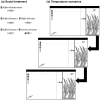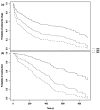Twoline Skiffia's Latency to Exit a Refuge and to Locate Food When Socialising With Invaders and Raising Temperatures
- PMID: 39830703
- PMCID: PMC11739607
- DOI: 10.1002/ece3.70813
Twoline Skiffia's Latency to Exit a Refuge and to Locate Food When Socialising With Invaders and Raising Temperatures
Abstract
Aquatic ecosystems are reservoirs of biodiversity and are highly threatened. Among the main threats to biodiversity are invasive species and global warming, the later has allowed the establishment of invasive species from originally warmer climates outside their native range by reducing the barriers to their establishment and distribution. Behaviour is the immediate response that species modify to counteract changes in their environment. Latency to respond to certain stimuli is an indicator of different behavioural tendencies associated with boldness, for example, quickly leaving a shelter could lead to benefits like finding a mate or locating food faster. We investigated the latency to exit a refuge and to locate food of the native twoline skiffia (Skiffia bilineata) from central Mexico at three temperatures (18°C, 23°C and 28°C) and in the presence/absence of invasive guppies (Poecilia reticulata). Our results are the first to show native fish could benefit from associating with invaders when emerging from a refuge and locating food under higher temperatures, but they would find themselves at the extreme of their thermal tolerance. Evidence of positive outcomes from biological invasions is increasing; however, further research is needed to understand if potential benefits for natives are temporary, which may make biological invasions less detrimental during the initial stages.
Los ecosistemas acuáticos son reservorios de biodiversidad y están altamente amenazados. Una de las principales amenazas para la biodiversidad son las especies invasoras y el calentamiento global que ha permitido el establecimiento de especies invasoras fuera de su rango de distribución nativa al reducir las barreras para su establecimiento y distribución. El comportamiento es la respuesta inmediata que las especies modifican para contrarrestar los cambios en su entorno. La latencia para responder a ciertos estímulos es un indicador de diferentes tendencias de comportamiento asociadas con la audacia; por ejemplo, abandonar rápidamente de un refugio podría resultar en beneficios como encontrar pareja o localizar alimento más rápidamente. Investigamos la latencia para salir de un refugio y localizar alimento del Tiro de dos rayas (Skiffia bilineata) nativo del centro de México a tres temperaturas (18°C, 23°C y 28°C) y en presencia o ausencia de guppies invasores (Poecilia reticulata). Nuestros resultados representan el primer hallazgo de que los peces nativos podrían beneficiarse de asociarse con invasores al salir de un refugio y localizar alimento bajo temperaturas más altas, pero se encontrarían en el extremo de su tolerancia térmica. La evidencia de resultados positivos de invasiones biológicas está aumentando, sin embargo, se necesita más investigación para entender si los beneficios potenciales para los nativos son temporales, lo que podría hacer que las invasiones biológicas sean menos perjudiciales durante las primeras etapas.
Keywords: behaviour; global warming; goodeids; invasive species; poeciliids; risk taking.
© 2025 The Author(s). Ecology and Evolution published by John Wiley & Sons Ltd.
Conflict of interest statement
The authors declare no conflicts of interest.
Figures


Similar articles
-
Effect of a temperature gradient on the behaviour of an endangered Mexican topminnow and an invasive freshwater fish.Sci Rep. 2022 Nov 29;12(1):20584. doi: 10.1038/s41598-022-24755-9. Sci Rep. 2022. PMID: 36446867 Free PMC article.
-
Sociability between invasive guppies and native topminnows.PLoS One. 2018 Feb 14;13(2):e0192539. doi: 10.1371/journal.pone.0192539. eCollection 2018. PLoS One. 2018. PMID: 29444149 Free PMC article.
-
Sex, size and habitat complexity effects on emergence latency and latency to locate food of the invasive porthole livebearer (Poeciliopsis gracilis).PLoS One. 2022 Jun 9;17(6):e0269384. doi: 10.1371/journal.pone.0269384. eCollection 2022. PLoS One. 2022. PMID: 35679286 Free PMC article.
-
The invasive twospot livebearer's biology, and its current and potential global distribution.J Fish Biol. 2023 Nov;103(5):854-863. doi: 10.1111/jfb.15483. Epub 2023 Jul 4. J Fish Biol. 2023. PMID: 37321972 Review.
-
Conceptualising the interactive effects of climate change and biological invasions on subarctic freshwater fish.Ecol Evol. 2017 Apr 26;7(12):4109-4128. doi: 10.1002/ece3.2982. eCollection 2017 Jun. Ecol Evol. 2017. PMID: 28649324 Free PMC article. Review.
References
-
- Alfonso, S. , Alfonso S., Gesto M., and Sadoul B.. 2021. “Temperature Increase and Its Effects on Fish Stress Physiology in the Context of Global Warming.” Journal of Fish Biology 98: 1496–1508. - PubMed
-
- Berger‐Tal, O. , and Saltz D.. 2016. Conservation Behavior: Applying Behavioral Ecology to Wildlife Conservation and Management, 21. Cambridge, UK: Cambridge University Press.
-
- Boteler, B. S. , Bodle R., and Donat L.. 2017. The UN Ocean Conference‐June 2017, Guidance to the ENVI Committee of the European Parliament. Brussels, Belgium: European Parliament.
-
- Braga, R. R. , Gómez Aparicio L., Heger T., Vitule J. R. S., and Jeschke J. M.. 2018. “Invasional Meltdown Hypothesis.” In Invasion Biology: Hypotheses and Evidence, 79–91. Wallingford, UK: CAB International.
-
- Camacho‐Cervantes, M. , Ojanguren A. F., Deacon A. E., Ramnarine I. W., and Magurran A. E.. 2014. “Association Tendency and Preference for Heterospecifics in an Invasive Species.” Behaviour 151: 769–780.
LinkOut - more resources
Full Text Sources

